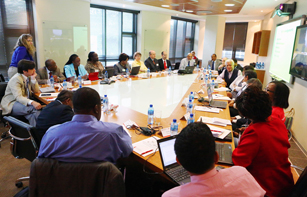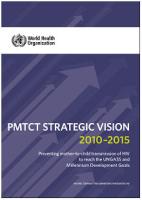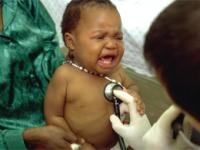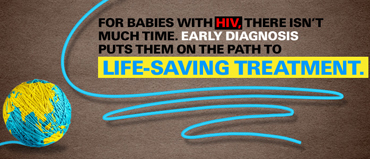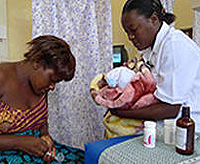
(Left to Right): Michel Sidibé, UNAIDS Executive Director; President Bill Clinton; Ban Ki-moon, Secretary General of the UN; Goodluck Jonathan, President of Nigeria; Dr Eric Goosby, US Global AIDS Ambassador, Anthony Lake, UNICEF Executive Director, at launch of the Global Plan towards elimination of new HIV infections among children and keeping their mothers alive, at UN Headquarters, NYC, 9 June 2011.
Credit: UNAIDS/B. Hamilton
NEW YORK/GENEVA, 9 June 2011—World leaders gathered in New York for the 2011 United Nations High Level Meeting on AIDS have today launched a Global Plan that will make significant strides towards eliminating new HIV infections among children by 2015 and keeping their mothers alive.
“We believe that by 2015 children everywhere can be born free of HIV and that their mothers can remain healthy,” said Michel Sidibé, Executive Director of UNAIDS. “This new global plan is realistic, it is achievable and it is driven by the most affected countries.”
“Nearly every minute, a child is born with HIV. Working together, we can reverse this tide as we have done in the United States and they are very close to doing in Botswana,” said Ambassador Eric Goosby, the United States Global AIDS Coordinator. “Preventing new HIV infections among children across the globe is truly a smart investment that saves lives and helps to give children a healthy start in life.”
Providing pregnant women living with HIV with antiretroviral prevention and treatment reduces the risk of a child being born with the virus to less than 5%—and keeps their mothers alive to raise them. Neither technical nor scientific barriers stand in the way of responding to this global call to action. The plan notes that what is needed is leadership, shared responsibility and concerted action among donor nations, recipient countries and the private sector to make an AIDS-free generation a reality.
In answering the Global Plan’s call to action, the United States President's Emergency Plan for AIDS Relief (PEPFAR) announced an additional US$ 75 million to preventing mother-to-child transmission of HIV (PMTCT) efforts. This funding will be on top of the approximately US$ 300 million that PEPFAR already provides annually for PMTCT.
The Bill & Melinda Gates Foundation pledged US$ 40 million, Chevron committed to US$ 20 million and Johnson & Johnson pledged US$ 15 million.
"Investments in preventing mother-to-child transmission are greatly needed and the Bill & Melinda Gates Foundation is committed to ensuring that such initiatives are fully integrated into family planning and maternal, newborn, and child health programmes," said Stefano Bertozzi, Director of HIV and tuberculosis at the Foundation.
“Chevron understands that its sustainability as a business is inextricably linked to the health and well-being of its employees and the communities in which it operates,” stressed Rhonda Zygocki, Executive Vice President, Policy and Planning, for Chevron Corporation. “We are proud to pledge US$ 20 million, joining in this mission to eliminate mother-to-child transmission of HIV.”
“We have a dream that no baby will be born HIV positive and today’s pledge continues the Johnson & Johnson enduring commitment to eliminating mother-to-child transmission of HIV,” said Brian Perkins, Corporate Vice President, Corporate Affairs. “It is another step in fulfilling our commitment to support achievement of the Millennium Development Goals, and reflects our long-standing dedication to improving maternal and child health.”
In 2009, approximately 370 000 children were born with HIV—almost all of them in low- and middle-income countries, mainly in sub-Saharan Africa. Under the Global Plan, the goal would be to work toward reducing this number by 90% by 2015. All 22 of the countries with the highest burden of new HIV infections among children have contributed to the development of the plan and signed up to implement it.

(Left to Right): Babalwa Mbono, Representative of Women Living with HIV; Michel Sidibé, UNAIDS Executive Director; President Bill Clinton at launch of the Global Plan towards elimination of new HIV infections among children and keeping their mothers alive.
Credit: UNAIDS/B. Hamilton
The Global Plan towards the elimination of new HIV Infections among children by 2015 and keeping their mothers alive was developed by a group of more than 30 countries and 50 community groups, non-governmental and international organizations. The group was convened by UNAIDS and PEPFAR.
Babalwa Mbono found out she was HIV positive when she became pregnant. “Helping pregnant women to protect their babies is really important,” she said. “Like all mothers, I would do anything to give my child a healthy start in life—and this prevention should be available to women everywhere.”
"We can only achieve a generation free of HIV and AIDS by focusing our efforts on the mothers and children at greatest risk and in greatest need," urged UNICEF Executive Director Anthony Lake. "The investments we make in preventing maternal-to-child transmission of HIV—and in expanding more women's access to quality care—will yield tremendous returns, not only in the lives of children and families affected by HIV and AIDS, but in improving mothers' and children's health in the poorest countries that bear the greatest burden of the AIDS epidemic."
The plan focuses on a series of specific policy and programmatic measures which countries will take to ensure that all pregnant women living with HIV have access to HIV prevention and treatment services and that new HIV infections among children are eliminated by 2015. The plan also includes efforts to provide treatment to mothers and children living with HIV during breastfeeding and referral to ongoing HIV prevention and treatment programmes thereafter.
The key elements of the Global Plan include ensuring that:
- All women, especially pregnant women, have access to quality life-saving HIV prevention and treatment services—for themselves and their children.
- The rights of women living with HIV are respected and women, families and communities are empowered to fully engage in ensuring their own health and, especially, the health of their children.
- Adequate resources—human and financial—are available from both national and international sources in a timely and predictable manner while acknowledging that success is a shared responsibility.
- HIV, maternal health, newborn and child health and family planning programmes work together, deliver quality results and lead to improved health outcomes.
- Communities, in particular women living with HIV, are enabled and empowered to support women and their families to access the HIV prevention, treatment and care that they need.
- National and global leaders act in concert to support country-driven efforts and are held accountable for delivering results.
The plan also includes a detailed timetable for action at community, national, regional and global levels to ensure rapid progress towards elimination of new HIV infections in children by 2015 and keeping their mothers alive.
About the Global Plan
This Global Plan provides the foundation for country-led movement towards the elimination of new HIV infections among children and keeping their mothers alive. The Global Plan was developed through a consultative process by a high level Global Task Team convened by UNAIDS and co-chaired by UNAIDS Executive Director Michel Sidibé and United States Global AIDS Coordinator Ambassador Eric Goosby. It brought together 30 countries and 50 civil society, private sector, networks of people living with HIV and international organizations to chart a roadmap towards achieving this goal by 2015.
This plan covers all low- and middle-income countries, but focuses on 22 countries [1] with the highest estimate of HIV-positive pregnant women. Exceptional global and national efforts are needed in these countries that are home to nearly 90% of pregnant women living with HIV in need of services. Intensified efforts are also needed to support countries with low HIV prevalence and concentrated epidemics to reach out to all women and children at risk of HIV. The Global Plan supports and reinforces the development of costed, country-driven national plans.
UNAIDS
UNAIDS, the Joint United Nations Programme on HIV/AIDS, is an innovative United Nations partnership that leads and inspires the world in achieving universal access to HIV prevention, treatment, care and support. Learn more at unaids.org.
PEPFAR
The U.S. President's Emergency Plan for AIDS Relief (PEPFAR) is the U.S. Government initiative to help save the lives of those suffering from HIV/AIDS around the world. This historic commitment is the largest by any nation to combat a single disease internationally, and PEPFAR investments also help alleviate suffering from other diseases across the global health spectrum. PEPFAR is driven by a shared responsibility among donor and partner nations and others to make smart investments to save lives. Learn more at www.pepfar.gov.
[1] Angola, Botswana, Burundi, Cameroon, Chad, Côte d’Ivoire, Democratic Republic of the Congo, Ethiopia, Ghana, India, Kenya, Lesotho, Malawi, Mozambique, Namibia, Nigeria, South Africa, Uganda, United Republic of Tanzania, Swaziland, Zambia and Zimbabwe.




